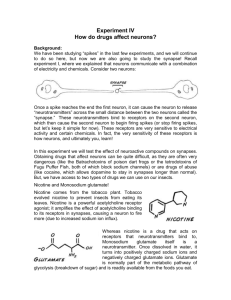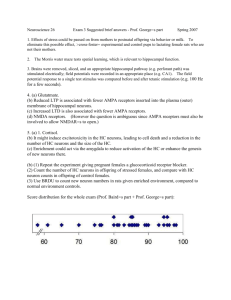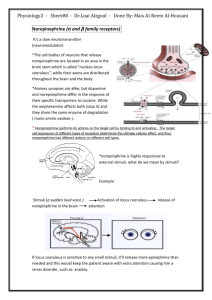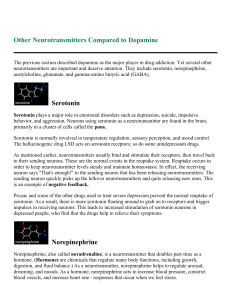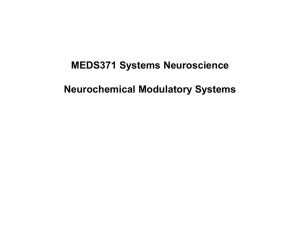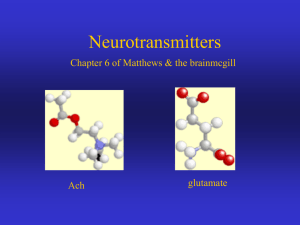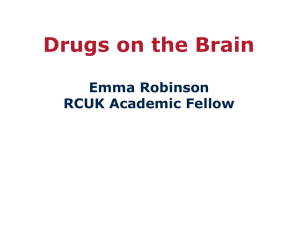George K. Aghajanian by Leo Hollister and Thomas A. Ban
advertisement
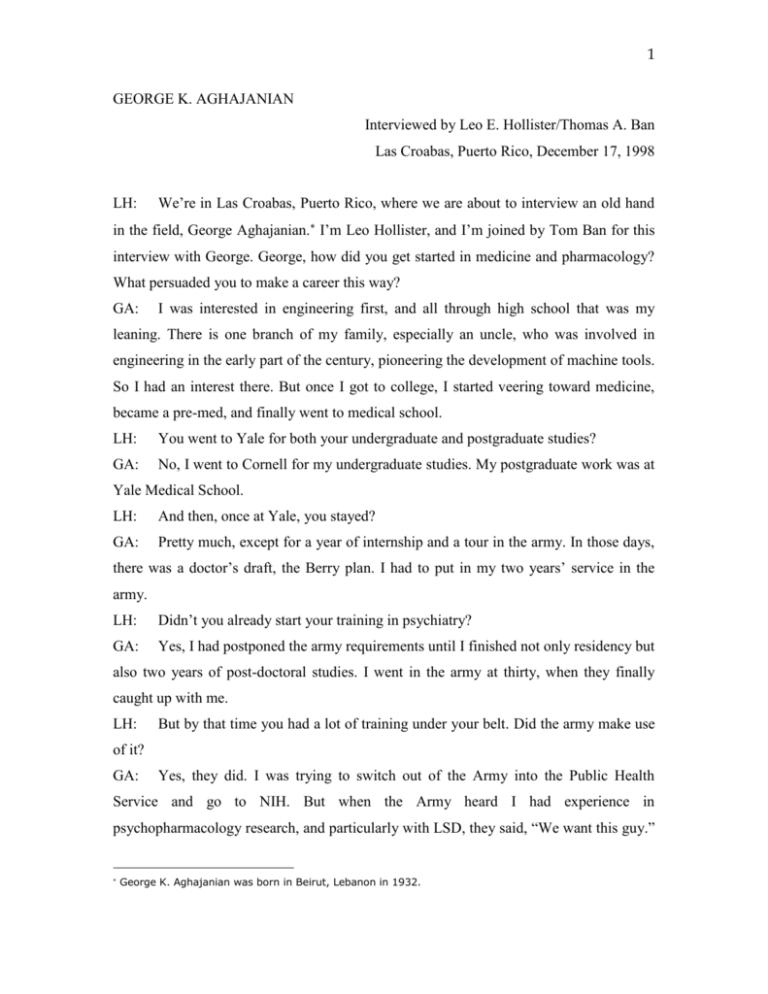
1 GEORGE K. AGHAJANIAN Interviewed by Leo E. Hollister/Thomas A. Ban Las Croabas, Puerto Rico, December 17, 1998 LH: We’re in Las Croabas, Puerto Rico, where we are about to interview an old hand in the field, George Aghajanian. I’m Leo Hollister, and I’m joined by Tom Ban for this interview with George. George, how did you get started in medicine and pharmacology? What persuaded you to make a career this way? GA: I was interested in engineering first, and all through high school that was my leaning. There is one branch of my family, especially an uncle, who was involved in engineering in the early part of the century, pioneering the development of machine tools. So I had an interest there. But once I got to college, I started veering toward medicine, became a pre-med, and finally went to medical school. LH: You went to Yale for both your undergraduate and postgraduate studies? GA: No, I went to Cornell for my undergraduate studies. My postgraduate work was at Yale Medical School. LH: And then, once at Yale, you stayed? GA: Pretty much, except for a year of internship and a tour in the army. In those days, there was a doctor’s draft, the Berry plan. I had to put in my two years’ service in the army. LH: Didn’t you already start your training in psychiatry? GA: Yes, I had postponed the army requirements until I finished not only residency but also two years of post-doctoral studies. I went in the army at thirty, when they finally caught up with me. LH: But by that time you had a lot of training under your belt. Did the army make use of it? GA: Yes, they did. I was trying to switch out of the Army into the Public Health Service and go to NIH. But when the Army heard I had experience in psychopharmacology research, and particularly with LSD, they said, “We want this guy.” George K. Aghajanian was born in Beirut, Lebanon in 1932. 2 They sent me to Edgewood Arsenal, the Army Chemical Center, to work on incapacitating agents that might be used in warfare. That was their idea at the time but no longer is. LH: I’m reminded of when I was first starting to work with reserpine, one of our staff in the hospital had the idea we could store the reserpine in Russian reservoirs and tranquilize them. So both sides were thinking the same thing. GA: People had some pretty odd ideas about that at the time. First, the Army had the lethal agents program with the acetylcholinesterase (AchE) inhibitors. But later, they also had an “incapacitating agents” program that included very high potency antimuscarinic compounds. LH: The BZ series. GA: Yes. That was the code name for the most potent ones. They also had the LSD program. LH: Outside of botulinum toxin, LSD is the most powerful biologically active substance known. GA: Certainly at the time. LH: One milligram a day is all you need and that’s pretty good. Okay. What did you do after two years in the army? GA: After I came out of the army in 1965 I returned to Yale and got an NIMH career development award. It made it possible for me to learn certain basic sciences. I started in electron microscopy and histochemistry, but in two or three years I shifted into electrophysiology. LH: So you were preparing for a research career in neuropsychopharmacology. GA.: In that regard, the person who had probably the biggest influence on me was one of the founders of ACNP, the late Daniel X. Freedman. Incidentally, I understand that he was the person who influenced ACNP to have their meetings in Puerto Rico. He was my thesis advisor when I was a medical student. LH: So Danny was in the department of psychiatry at the time. GA: Yes. When I was a medical student in the late 1950s, he was a young faculty member in a department that was predominantly psychoanalytically oriented. LH: That was when Mort Reiser was chairman? 3 GA: Before that. LH: When Fritz Redlich was chairman? GA: Yes, Fritz Redlich was the chairman and his interests were quite eclectic, although he came from an analytic background. But there were Ted Lidz, Steve Fleck and many others in the department who had a dynamic, analytic orientation. It was a very interesting department; they were quite good in psychodynamics. It was Danny Freedman in the late 1950s who started the biological program in the department. LH: He was working on it primarily with Nick Giarman. GA: That’s quite right. Your memory is very good. Nick Giarman was in the pharmacology department and it was through Nick Giarman that Dan Freedman was able to get a program going in neuropsychopharmacology. It was a joint program in pharmacology and psychiatry. So Dan was responsible for getting a number of people started in the field. I think that was one of the first training programs in neuropsychopharmacology. LH: Who were some of the others in the program? GA: Herb Meltzer and Jack Barchas were medical students like me at the time. Jack Barchas was in the class behind me. LH: So the program was an incubator for neuropsychopharmacologists. GA: Dan Freedman was a magnet for people who were interested in neuropharmacology and psychopharmacology. LH: Was he always as nice a guy as I knew him? GA: That was my entire experience with him. He was always very encouraging to young people. LH: He was a fine gentleman. GA: It was very important in the late 1950s and early 1960s for someone starting out in the field of neuropharmacology to have encouragement, because that was not the accepted way in psychiatry at that time. I was actually told that there would be no future for someone like me in academic psychiatry without getting analytic training. In fact, Dan did that even while bringing forth his neuropharmacology training program. LH: He had a degree in psychology, as well, didn’t he? GA: Yes, I at a college level. I don’t think he had a PhD in psychology. 4 LH: Do you suppose that Nick’s interest got you into research? GA: Yes, along with Danny. I did my medical school thesis on LSD. People, today wouldn’t believe that LSD was not a controlled substance at that time. LH: You could order it from the drug company. GA: Sandoz would send it out to any physician who wrote in a request. There were ampoules of LSD lying around all over the place. LH: I’ve still got 100 milligrams of LSD powder to make a solution. You could order it from biochemical supply houses without any control. GA: Dan left a supply of LSD with me when I was a medical student, between my junior and senior years. I was doing a behavioral study on LSD when he went for sabbatical to NIH for a year. He just left with me a large supply of ampoules. LH: What year was that? GA: The summer of 1957. LH: That was pretty early in the game, wasn’t it? GA: Yes, it was. LH: It’s pretty amazing that from 1943, or whenever the accidental discovery was made, how the number of papers on LSD started to escalate. GA: It was only in 1953 and 1954 that the interaction between LSD and serotonin was discovered and the possible relevance of this interaction to the biochemistry of mental illness raised. The structure of serotonin had been discovered only a relatively short time before that. So it was only about three years later; Giarman had just come back from a sabbatical in Gaddum’s laboratory in England. Gaddum was one of the co-proponents of the serotonin hypothesis of LSD’s mechanism of action. LH: He developed a hypothesis about schizophrenia based on the antagonism between LSD and serotonin. Who was the other guy from New York who got the same idea? GA: Woolley. LH: Woolley and Shaw. GA: They started with their research in New York about the same time as Gaddum was doing his work in England. Gaddum first published in 1953 and Woolley and Shaw in 1954. LH: But they weren’t using it as a neurotransmitter. 5 GA: They had no idea about its role as a neurotransmitter. The serotonergic systems were not discovered until 1965. LH: It was probably all done in platelets. GA: By 1953, it was known that serotonin was present in the brain. Nick Giarman thought of it as a neurohumoral substance. He referred to it as a substance that was present in the brain. There was no specific knowledge that it was actually within a specific set of neurons and might be a transmitter used by those neurons. That wasn’t known until 1965. LH: I suppose Brodie and his crew established prior to that, that serotonin has an important role in the action of reserpine. GA: Certainly. Levels could go up and down; reserpine could deplete serotonin, but it wasn’t known where the serotonin was in the brain. They were working with whole brain, with brain homogenates. At that time, nothing was known about the neurotransmitter role or localization of serotonin. All those classical studies of Brodie, Carlsson, Freedman, and others were done on brain homogenates. It was Freedman who found that LSD affected the levels of serotonin and its metabolites in the brain. LH: I think it was also Danny Freedman and Nick Giarman who first came up with the idea that LSD produces a model psychosis by affecting serotonin. GA: By the time they suggested that in the 1950s the model psychosis idea was around quite widely. LH: I used to have friendly arguments with Danny about just how good the LSD model was for schizophrenia. But, regardless, he certainly started you out on the trail of neurotransmitters. You’ve studied them over the course of a lifetime. GA: I started as assistant professor in the department when I got back from the army. It was at the time when the discoveries of the Swedish histochemists were published, showing for the first time that the origin of serotonin is in the raphé neurons of the brain stem and the fibers from those cells containing serotonin projected to all other parts of the brain. The information on the release of serotonin came just a little bit later. In one of my first studies I was showing an increase of serotonin metabolites in different parts of the brain after electrical stimulation of the raphé neurons in the brain stem. This was indicative that serotonin had been released. 6 LH: Did you measure it chemically or histochemically? GA: I measured it chemically. That was about 1966–67. LH: That was when fluorescence made the scene. GA: Fluorescence measurements were already on the scene. That was when I switched to electrophysiology because I thought the activity of these neurons might be very important for determining what their function was. I had no background in electrophysiology, but I was able to interest a post-doc in the neighboring laboratory of the late John Flynn from Yale in starting some studies of this nature. We did our research at night. On the basis of Danny Freedman’s findings that LSD raises the levels of serotonin but decreases its metabolites, I hypothesized that LSD might be inhibiting the firing of serotonergic neurons, and as a result the released neurotransmitter would back up but its metabolites would go down. LH: Well, that’s one of the possibilities, isn’t it? GA: We did the first experiment one night in the winter of 1967, and it did work. Nine out of ten, or ninety-five out of a hundred of my hypotheses do not pan out, but that one did. So I became a confirmed electrophysiologist from that time. LH: Over the years, I noticed, you published papers with three ACNP presidents: Danny Freedman, Floyd Bloom, and more recently Steve Bunney. GA: Yes. Floyd Bloom and I were in the same laboratory studying electron microscopy in the 1960s. Steve Bunney was one of the first post-doctoral students in my laboratory. He was a resident in our program in the early 1970s. LH: And that’s where he learned his electrophysiology? GA: Yes. His older brother, William Bunney or Biff Bunney – whom I had known for some years because we overlapped in residency at Yale – steered Steve my way. Steve started with no experience whatsoever, as a post-doc in my laboratory. LH: The first time I ever heard Steve Bunney give a paper it was at the ACNP meeting in Phoenix, I think. I was impressed and afterward I asked him, “Why don’t you get your older brother to nominate you for membership of this organization?” And he did. If you had to pick out of your many papers two or three you think represent your best work, which ones would you pick? 7 GA: The papers describing the recording of the electrophysiological properties of the monoaminergic neurons; it was made possible after the Swedish histochemists published maps showing where they were. The first recordings of this kind were of the effect of LSD on the firing of serotonergic neurons. Then, within the next two or three years in my lab, we went on to record from the dopaminergic neurons and a neurons in the locus coeruleus. That series of studies and the ensuing papers represent my best work. They were the first recordings from monoaminergic neurons and described their basic electrophysiological properties and the effects of drugs on their firing rate. That started off many studies in this area of research, and as you know, became a major industry. LH: Oh, yes. GA: We did that early work in a period of five years starting in 1967 and running until about 1973. We did the LSD studies and described the electrophysiological properties of serotonergic neurons in 1967 and 1968, and published our findings in Science. We did the first studies on noradrenergic neurons in 1971 with a medical student working for the summer in the lab. Then, when Steve Bunney came along, his project was to record from dopaminergic neurons. That was in 1973. LH: Was he doing it in a single neuron? GA: Yes, in single neurons. Many of the properties of the monoaminergic neurons that are well known today were discovered in those studies. We learned that serotonergic neurons release serotonin in very slow tonic firing; that the tonic firing of noradrenergic neurons is very reactive to sensory stimuli; and that the firing of dopaminegic neurons is affected by amphetamines and antipsychoticdrugs. One of the main principles derived from those studies is that monoaminergic neurons have autoreceptors in the somatodendritic region for their own transmitters and that these autoreceptors serve as a negative feedback regulating their activity. LH: Well, that’s an established principle now. GA: Yes, that principle was derived from findings in these early studies. LH: That’s landmark work. GA: It had a major impact for many years on the development in that field through the work of many, many investigators. LH: Did you ever think that serotonin would be as versatile as it seems to be? 8 GA: I certainly did not. LH: I don’t think anybody did. GA: I remember when Eli Lilly was developing fluoxetine in the early 1970s, they were not confident they were working on a drug that had any future. But there were a few people who did. LH: More in Europe than in America. GA: You’re absolutely right. In Britain, there were those who were inclined toward thinking that serotonin would have a role in affective disorders. Also, in Sweden, Arvid Carlsson believed that serotonin might be important for depression. In fact, Arvid Carlsson was involved in the development of a serotonin reuptake inhibitor, zimelidine. LH: That looked pretty good for some time, didn’t it? GA: Yes, but it had certain toxicities and was dropped. Meanwhile, Eli Lilly was developing fluoxetine, but because the developers were not confident about marketing of the drug, the basic science work went on for some years before fluoxetine got into clinical testing. LH: If you look back though, both imipramine and amitriptyline were serotonin uptake inhibitors, but they also had an effect on norepinephrine. I used to joke that in this country we bought more norepinephrine than in Europe whereas in Europe they bought more serotonin. GA: In recent years, because many atypical antipsychotic drugs block the 5-HT2A receptor, interest in serotonin everywhere reawakened. LH: Do you think that has anything to do with their antipsychotic action? GA: The most critical test of this is currently ongoing. The atypical antipsychotic drugs that we had in the past also have other actions. Of course, it’s difficult to sort out the 5-HT2A blocking component in their action from the other components. Among the currently used drugs, risperidone comes the closest for testing the relationship between blocking 5-HT2A and antipsychotic action. It has a very high potency in blocking 5-HT2A receptors. It is about ten times more effective blocking 5-HT2A receptors than D2 receptors. Risperidone has now been clearly shown to be an effective antipsychotic, and it has antipsychotic effects in a dose range where primarily it occupies 5-HT2A receptors without occupying D2 receptors. In higher dose ranges risperidone will occupy D2 9 receptors and produceextrapyramidal side effects. There is a drug which was originally called MDL 100907 and now M100907 because the new company couldn’t get that many digits into their coding system. It has just gone through Phase-III clinical trials. LH: Is M100907 solely a 5-HT2A blocker? GA: It doesn’t touch D2 receptors. LH: Well, we shall see. I’ve been of the opinion that all of the atypical antipsychotics have in common a weak D2 antagonism and that D4 or D1 antagonism doesn’t mean a damn thing. Probably serotonin antagonism doesn’t mean anything, but I may be completely wrong on that. GA: That’s why this new drug, MDL 100907 is so important. LH: Wasn’t ritanserin selectively blocking serotonin receptors? GA: Ritanserin does block 5-HT2A receptors, but it also blocks 5-HT2C receptors, and it also interacts with a number of other receptors, so it is not quite as suitable for testing the relationship between blocking 5-HT2A and antipsychotic effects. LH: It bombed out as an antipsychotic. GA: It was said to be useful in improving negative symptoms, but maybe not the positive symptoms. It’s quite interesting that ritanserin doesn’t seem to do the trick, even in animal models. LH: So it’s not a true test of the idea? GA: MDL will be the true test and the results are being analyzed now. But the question in my mind is being so selective as we believe, will it work, and if so would it be in just a subset of patients? Probably, all schizophrenias are not the same, and it might pick out a subset of schizophrenias where the 5-HT2A receptor is important in the pathophysiology; whereas it might not have an effect on other schizophrenias where the 5-HT2A receptor is not involved. That brings me to the topic of recent research of mine. I’m inclined to think these days that it’s really not the monoamine receptors that are primarily involved in antipsychotic effects, although they may have some impact. I don’t think the existing antipsychotic drugs are so effective anyway. We know that schizophrenic patients are not going to pop back to normal living after they are given an antipsychotic drug. So, in our recent research we are studying whether an abnormality of glutamate release might also 10 be involved. We were led to this hypothesis by studies on the mechanisms of 5-HT2A receptor activity, and the recognition that the 5-HT2A receptors are concentrated in the cerebral cortex. It makes a lot of sense they are concentrated in the cerebral cortex because psychedelic hallucinogens that work through the 5-HT2A receptor, and possibly to some degree through the 5-HT2C receptor, produce not only hallucinations and illusions but have an effect on all cortical functions, including cognitive and affective. In recent years we’ve been studying, electrophysiologically, the role of 5-HT2A receptors in the psychoses induced by hallucinogens. We found that hallucinogens work as partial agonists of 5-HT2A receptors in that they don’t have serotonin’s full effect. What makes a hallucinogen, we believe, is that they lack the other actions of serotonin that counterbalance the dramatic increase in 5-HT2A receptor activity. In other words, they leave the increase of 5-HT2A activity unopposed. However, it is not necessarily the over-activity of 5-HT2A receptors that produces the hallucinogenic effect but rather, as our studies show, it is an abnormality of glutamate release that might be responsible for endogenous psychoses. If overactivity of 5-HT2A receptors were responsible, then drugs that block 5-HT2A receptors should work right away. However, they don’t. Even with MDL 100907, there seems to be a two, three or four week delay in the onset of therapeutic effects. Currently there are also ongoing studies with the ketamine model of psychosis. Ketamine is an antagonist of one type of glutamate receptor, the NMDA receptor. The ketamine-model of psychosis at first glance seems to be a completely different model from the LSD, or psychedelic hallucinogen model of psychosis. LH: I thought it was a much more realistic model. GA: People have debated that because there’s some overlap between the two models. One obvious difference is that NMDA receptors are blocked with ketamine but not by the psychedelic hallucinogens. Recently, however, Bita Moghaddam, a member of ACNP, found that ketamine induces an increase in glutamate release in the cortex, and since the effects of psychedelic hallucinogens have also been attributed to an increase of glutamate release, the two models seem to share a common mode of action. There are also findings in PET imaging studies in Europe that have shown hypofrontality, similar to that seen in schizophrenia, after the administration of mescaline, a psychedelic hallucinogen, and also 11 after the administration of ketamine. During the past few years the so-called metabotropic glutamate autoreceptors have been discovered, and it has been shown that glutamate can act on these autoreceptors to suppress glutamate:release by a negative feedback mechanism. In this respect the glutamatergic system is analogous to the monoaminergic system where monoamines can act on their autoreceptors to suppress monoamine release. At this time, agonists of these metabotropic autoreceptors have been developed that can block the effect of psychedelic hallucinogens. This fits with the idea that the effects of psychedelic hallucinogens are mediated through an excessive release of glutamate. Furthermore, Bita Moghaddam has also shown that the same metabotropic receptor agonist that blocks the excessive release of glutamate induced by ketamine or PCP also blocks the behavioral effects of these substances. So we have at this time two glutamate models of psychosis, a psychedelic hallucinogen model and a ketamine/PCP model. LH: I would have thought so, because clinically, the differences are substantial. GA: That’s quite true. One of the major differences is that there is blockade of NMDA receptors in the ketamine/PCP model. LH: Then there’s also a glutamatergic-dopaminergic link. GA: Where that fits into the picture is a little unclear. Bita Moghaddam has shown in her studies, that PCP and ketamine increase dopamine release, but metabotropic receptor agonists don’t interfere with that effect. So we’ve got a new ball game here. LH: How exciting! I’d given up on hallucinogens. GA: It’s so exciting that Eli Lilly has become the leading developer of metabotropic receptor agonist drugs. These drugs are analogs of glutamate with different side groups. It had been believed that such drugs would not enter the brain, because they are too polar, but Lilly has succeeded in developing highly potent agonists, with nanomolar potency, that can be given systemically and enter the brain. LH: Are they actually bioavailable or do they just overwhelm you with their potency? GA: They have surprising bioavailability. They may actually be transported into the brain, but that has not been established yet. LH: I think they are transported into the brain. 12 GA: They might be, through amino acid transporters, but that has not been shown yet. These drugs are effective in animals in very reasonable doses. They were originally developed for use in the treatment of anxiety disorders, and are being used currently in clinical trials in these disorders. But now, because of the new findings that implicate excessive glutamate release in both the ketamine/PCP and psychedelic hallucinogen models of psychosis, Eli Lilly, through Bita Moghaddam’s and our efforts, is contemplating clinical trials in schizophrenia with these substances. We’re anxiously awaiting the inception of those trials. I’ve just brought you right up to the present. LH: This is exciting, because we’ve been desperately trying to get off the dopamine hypothesis. GA: This even gets us off the serotonin hypothesis and gets us to the glutamate hypothesis, because all roads lead to either glutamate or GABA. One can think that monoamines are interacting with their G-protein coupled second messenger pathways influencing gene expression, but in terms of their immediate electrophysiological effects the main function of monoamines is the modulation of excitatory and inhibitory amino acid transmission. LH: GABA and glutamate are far more abundant in the brain than monoamines, aren’t they? We talk so much about the amines, but they are there in relatively small amounts. GA: Right. So one can think of a defect downstream of the monoamines and a defect, let’s say, in the glutamate release mechanisms. Monoamines through their action via monoamine pathways may have some influence on a defective glutamate release mechanism. Perhaps the influence will not be great enough and will be too slow to translate into optimal efficacy. So, we are hypothesizing that the monoamines have a rather indirect and distant influence on what may be the core pathology, which would be downstream, involving glutamatergic or GABAergic transmission. What might provide specificity is that the metabotropic receptors which modulate glutamate release and transmission are expressed differentially in different parts of the nervous system. There’s one type of metabotropic receptor that’s very strongly expressed in the cerebral cortex in fibers that, we think, are involved in the action of the psychedelic hallucinogens. LH: This isn’t history. This is bringing us up to date. I didn’t realize all these things are going on. 13 GA: I would say there are a good dozen posters on studies dealing with metabotropic glutamate receptors at this meeting. LH: Well, out of five hundred posters it’s hard to find a dozen. GA: Eli Lilly has already shown that one can make highly selective drugs that hit predominantly one or another subtype of metabotropic receptor. So it’s going to be very exciting in the coming years to see how these drugs, with an action on different subtypes of metabotropic receptors, will effect mental functioning, and ultimately what therapeutic benefit their use might have. The first of these drugs, LY354740, as I mentioned earlier, has already been tested in anxiety disorders and does seem to have anxiolytic properties. Moreover, these drugs should work very rapidly because they reach to the heart of the matter rather than influencing it indirectly as the monoamines have been doing. LH: Well, there are lots of surprises. So, you come from monoamines all the way up to glutamate and the other transmitters. GA: To me, the connection with glutamate was a surprise. We started only three years ago with these studies looking at the effect of 5-HT2A receptors on glutamate transmission, and at that time we had no idea how the metabotropic agonists might fit into that scheme. Nor did we have any idea that there were drug companies developing selective agonists of metabotropic receptors that would block the effects of hallucinogens. LH: That’s a novelty in itself. GA: This has all happened in the last two or three years. LH: Well, you’ve had a really exciting career. GA: Yes, it’s very exciting. One difference between the way things were in the 1960s, when I got started, and are now is that there was very little knowledge about brain systems at the time. It would take years to follow up any findings, but now things happen very quickly. The base of knowledge is expanding so much it makes one envious of the people who are starting out now. The knowledge basis is so much greater and the tools one has to work with are so much better than they were. The one way I would not be envious is that people starting out have a tougher road, because there’s greater competition. There are so many more people in the field. When I was starting out, there was hardly anyone doing what I was. In fact, there was no one. But now, that’s not the 14 case. A young investigator comes up with some novel finding, and in no time at all, ten other labs will be doing it. LH: One of the sad developments is that people are reluctant to share new information for fear it will be co-opted. GA: When I started recording from monoaminergic neurons, no one else was doing it, and it actually took several years before other people started. LH: Now, it would be several weeks. GA: Yes, I think so. LH: Well, thank you, George, for coming by and sharing parts of your most interesting career. I think we’re going to have you back in another ten or fifteen years to bring the history up to date. GA: I don’t know about that because I’ve developed another interest, which might have a higher priority in the next ten or fifteen years. That’s a game one plays with a funny looking stick and a little white ball you hit down a fairway. I’ve been corrupted! LH: Thanks for spending time tracking the electrophysiology of neurotransmitters and I wish you a lot of luck with the golf. I’m sure Tom does, too, because, as clinicians, we feel deprived, not being in the forefront of things and not having as many drugs to offer patients as we would like.

